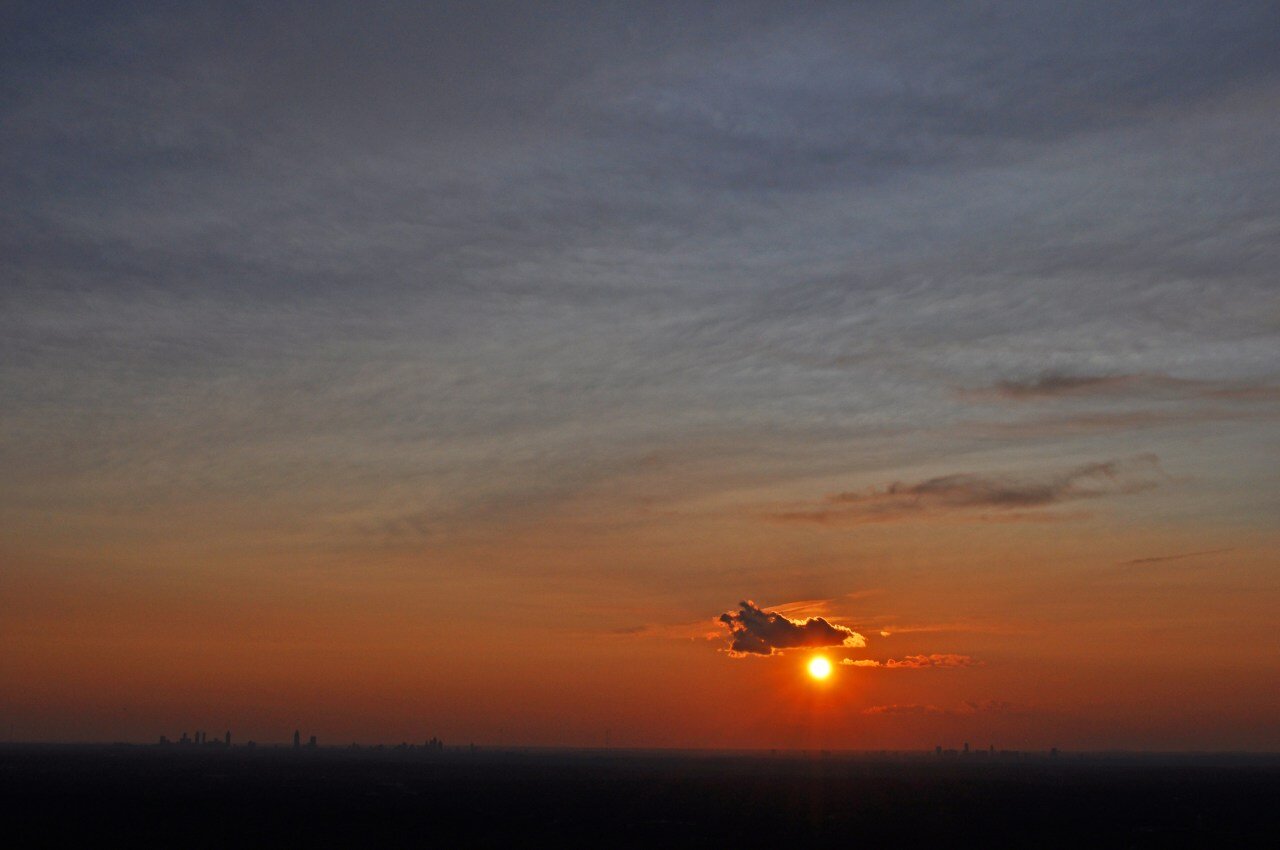Sunsets at Atlanta’s Monadnocks: Who Wore It Best?
Hello, and welcome to my hometown! While I think that travel is basically one of the best things ever, I also think that exploring your own backyard can sometimes be just as rewarding. And since I’ve been spending a lot of time cramming my brain with as much new information as possible lately, I’ve been at home for the past few months. So. Much. Learning. BUT! In an attempt to balance out all the weird real life adulting and working and stuff that I’ve been doing, I have been exploring. It doesn’t always have to take a crazy vacation in order to go on an adventure! Because of all my hometown adventures, this is going to be the first of (hopefully) many posts to come outlining all the awesome things to do in Georgia. Spoiler alert: a lot of those things include mountains.
Like today. Today, we are headed up Atlanta’s Monadnock Mountains. What in the world is a monadnock, you say?? “Monadnock” is a Native American word that just means a rock hill. And that’s exactly what Atlanta’s Monadnocks are: rock hills. Being just south of the Appalachians, we affectionately refer to our monadnocks as mountains, but in reality, they are just gigantic rocks.
At the beginning of this summer, I convinced one of my indoorsy friends to come outside with me on a guided moonlight hike of Panola Mountain (shout out to her for being the bomb), and, after experiencing the sunset on top of the mountain, I thought it might be fun to watch the sunset from each of the monadnocks and see how they stack up. Thus, my first Atlanta hiking adventure.
While the monadnocks are all geologically similar, each one offers a different experience from the next. I had a great time hiking each one for different reasons, and I’m excited to share my definitive answer to the age old question: who wore it best?
Panola Mountain
We can start with my first hike of the summer, Panola Mountain. Panola is definitely the most unique of the three, and also the least-hiked. While the mountain itself resides within a state park of the same name, it is protected and does not allow hikers without a guide. Luckily, the park offers guided hikes occasionally, so it’s not totally off limits. During the hike, the guides explain a lot of the geology and history of the mountain, which makes for a fun and informative hike. Unlike Arabia and Stone Mountains, the rock found on Panola Mountain was seen as unfit for excavation, leaving it virtually untouched. This allowed for all kinds of organisms to continue to grow there over time without interference, so the ecosystem atop Panola Mountain is very similar to what would have been found thousands of years ago. It is a rare gem.
We gathered in the visitor’s center parking lot before the hike, and followed the park ranger and volunteer guides down a pine-strewn trail to the base of the mountain. Here, we zigzagged up a steep incline of rock toward the flat and more level face of the mountain. The guides knew the path well, and were able to lead our single file line to safety without a hitch. Once our whole group of about twenty hikers had reached level ground, the guides pointed out where to step to avoid interfering with the fragile plant life and we stayed in a single line, careful to follow each other’s footsteps. We were lead around the top of the mountain to the best view of the sunset—west, behind the city skyline—in time to snap a few photos. Flashlights slowly began to flicker on after the sunset as the sky gradually grew darker, and we hiked a little further before beginning our descent the way we came.
I had debated what shoes I was going to wear to this hike (gym shoes or hiking boots?) and settled on hiking boots since I was unfamiliar with the terrain. This ended up being a wise choice; the tread on my boots is much stronger than on my tennis shoes, and I felt much safer climbing up and down the side of a rock in them than I would have otherwise!
It is also worth mentioning that these guided hikes at Panola Mountain aren’t free. We paid $15 each, but I was happy to shell out some cash for the novelty of the experience, and I’m always happy to support my state parks!
Arabia Mountain
Arabia Mountain was next on the list! I was particularly excited for Arabia Mountain having never been before, and it was more beautiful than I expected! Arabia is only a few miles away from Panola, and the same paved walking/biking path runs through both parks. We parked at the nature center and followed the path south to the boardwalk until we reached the south parking lot. If you aren’t looking to do too much walking, you can park at the south lot and follow the only half a mile trail up to the top of the small mountain.
Arabia Mountain seems almost otherworldly. There are no trees growing on the large rock, and the “trail” is marked by stone outcroppings. It is delightfully different from most hiking trails in Georgia, and my main complaint regarding Arabia is just that the trail is not longer! It left me wanting more, but luckily we arrived an hour early for the sunset and spent our time romping around the top of the mountain. It was also very uncrowded. We shared our playground with only a few other people, and there was plenty of space to go around. We stayed on Arabia to watch another stunning sunset, but promptly descended following the event as to not be caught in the dark for too long.
Arabia Mountain makes for a very mild hike, and is a great option for non-hikers or beginners looking for a big return on a small investment.
Stone Mountain
And last, I ascended Stone Mountain the following weekend (looking to earn my weekend warrior status)! Stone Mountain is far and away the most famous of Atlanta’s monadnocks. It is the largest of the three, and lives inside a park that functions more as a theme park anchored by a natural wonder than a park that allows nature to speak for itself. Stone Mountain Park is a place for raucous family fun, and the hiking trails tend to take a backseat. Nonetheless, I have hiked up Stone Mountain plenty of times in my lifetime as an Atlantian and returned on this occasion to experience a sunset from the summit.
Stone Mountain is the polar opposite of Panola Mountain in many ways, but mainly in the sheer number of people with whom I shared the trail. Being the tallest makes it the most strenuous climb, but being the most popular also comes with a price: there is a cable car system that shuttles non-hikers to the summit. While this is a fantastic way for the less-able to get the full experience of Stone Mountain Park, it also ensures that the summit of the mountain is far more crowded than it would be if it were only hikers atop.
Stone Mountain has the most growth along the side of the rock, but, like the others, is mostly barren at the summit. Also, owing to the need to cater to the vast amount of visitors the mountain receives, it also has the most evidence of humans, with trashcans, electrical wires, and even handrails at the steepest sections along the trail. These can be somewhat of a distraction, especially when comparing Stone Mountain to the other two monadnocks, but it would be ridiculous to say that the mountain is not a great trail because of these things.
Reaching the top of Stone Mountain was the most rewarding of the three climbs, and again, I summited with plenty of time to spare. I quickly scouted out my spot from which to watch the sunset, and then entertained myself by people watching until the sun retired for the day.
Which Monadnock Wins?
It’s been a few weeks since I finished up my sunset hikes, and I have been deliberating on my final judgment ever since then. All three of the monadnocks were delightfully unique from the next, which was something I hadn’t expected from three very geologically similar rocks. Also, they each had their own strengths and drawbacks. At right around one mile long, Stone Mountain’s hike was the longest and most strenuous, and therefore the most rewarding to summit. However, the large hoards of crowds and expensive entry fee ($15 just to enter the park!) were a little bit of a negative for me. Panola Mountain is a highly preserved ecosystem, and therefore a rare treat to walk amongst, but also means that you must be extremely aware of each step you take during your visit. Arabia Mountain was almost empty, and we were free to run and explore as we wished, but the trail was disappointingly short.
I think, though, if I’m forcing myself to choose a favorite sunset experience, it would have to be Arabia Mountain. The freedom to experience the trail on our own terms and the scarcity of other visitors made it a wonderful place to slow down and watch the sun set, and experience a little piece of nature right outside the bustling city of Atlanta.
As far as choosing the sunset itself, I couldn’t decide! Which one is your favorite?















